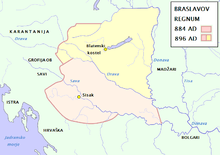Pannonian Croatia
Lower Pannonia (Latin: Pannoniae Inferioris), located in the southwestern parts of the former Roman province of Pannonia, was held by Slavic rulers between the fall of the Avar Khaganate starting in the 790s, and the Hungarian conquest of the Carpathian Basin in the 890s. Initially, the Slavic counts were under Frankish suzerainty, part of Frankish Pannonia,[1] and are known from Frankish primary sources.
Nomenclature
Contemporary sources call the polity Lower Pannonia (Pannoniae Inferioris) during the rule of Ljudevit Posavski, Ratimir, Pribina, Koceľ and Braslav.[2]
In the 19th- and 20th-century Croatian historiography, the focus was usually placed on the territories between the rivers Drava and Sava, referring to them as Pannonian Croatia (Croatian: Panonska Hrvatska), or Southern Pannonia, or just Pannonia. The term "Pannonian Croatia" has been used by older Croatian historians to describe this entity in a manner that emphasizes its Croatian nature.[3] Contemporary sources did not actually use the Croatian name as such until the latter half of the 9th century, rendering the name anachronistic before then.[3][4]
Prelude
Under the Roman emperor Diocletian (284-305), Pannonia was divided into 4 provinces: Pannonia Savia, Pannonia Prima, Pannonia Valeria, and Pannonia Secunda. The rivers of the Pannonian Plain formed most of their borders, mainly Danube, Drava, and Sava. This system persisted with the Diocese of Pannonia until the 440s.
History
Vojnomir
After the defeat of the Avar Khaganate by Frankish troops, a certain Vojnomir was assigned Savia as a vassal of the Frankish margrave of Friuli.[5]
Ljudevit
Ratimir
In 827, the Bulgars under Great Khan Omurtag invaded and conquered Lower Pannonia and parts of Frankish territories to the north. In 829 the Bulgars imposed a local Slavic prince, Ratimir, as the new ruler of Pannonia. His province is believed to have been the territory of Roman Pannonia Savia.[6] In 838, nine years later, following the Bulgar conquest of Macedonia, the Danubian count Radbod, prefect of the East March, deposed Ratimir and restored Frankish rule in Pannonia. Ratimir fled the land, and the Franks next instated Slavic princes Pribina and Kocel as rulers of Pannonia.
Braslav

Braslav was the governor of the Duchy of Pannonia between 884 and 896. His duchy initially included Lower Pannonia, between the Drava and Sava, and he served Arnulf of Carinthia. He participated in the Frankish–Moravian War, and in 896 Arnulf handed over Pannonia to him in order to secure the Frankish frontier against the Hungarians, however, the Hungarians subsequently overran all of Pannonia and continued into Italy.
Aftermath
Following the rise of the Principality of Hungary in the mid 890s, no further Slavic rulers were recorded in the territory until the mid 920s when the Duke of Croatia Tomislav united the territory with Dalmatian Croatia to form the Kingdom of Croatia.[7]
There has remained a general uncertainty and dispute over the relationship between the Croatian and Hungarian kingdoms in the 10th and 11th century, with Croatian historian Ferdo Šišić and his followers assuming Tomislav of Croatia had ruled most of the area inhabited by Croats, including Slavonia, while the Hungarian historians Gyula Kristó, Bálint Hóman and János Karácsonyi thought the area between Drava and Sava belonged neither to Croatia nor to Hungary at the time, an opinion that Nada Klaić said she would not preclude, because the generic name "Slavonia" (lit. the land of the Slavs) may have implied so.[8]
See also
Part of a series on the |
|---|
| History of Croatia |
 |
|
Early history
|
|
Middle Ages
|
|
Modernity |
|
Contemporary Croatia |
| Timeline |
| Croatia portal |
- List of early East Slavic states
- Principality of Nitra
- East Francia
- Great Moravia
- Principality of Hungary
- Duchy of the Croats
- Kingdom of Croatia
- Dukes of Croatia
- Ban of Slavonia
References
- ↑ Oto Luthar (2008). The Land Between: A History of Slovenia. Peter Lang. p. 105. ISBN 978-3-631-57011-1.
- ↑ Jugoslavenska Akademija Znanosti i Umjetnosti (Zagreb) (1871). Rad Jugoslavenske Akademije Znanosti i Umjetnosti 16. Akad. p. 8.
Pannonia inferior cum duce Braslao ad officium rediit
- ↑ 3.0 3.1 Gračanin, 2008
- ↑ Goldstein, 1985, pp. 241–242
- ↑ Mediaeval Academy of America (1945). Speculum. University of California. p. 230.
- ↑ Ernst Dümmler (1856). Über die älteste Geschichte der Slaven in Dalmatien: (549-928). Braumüller in Komm. pp. 46–.
- ↑ Opća enciklopedija JLZ. Yugoslavian Lexicographical Institute (Zagreb). 1982.
- ↑ Heka, Ladislav (October 2008). "Croatian-Hungarian relations from the Middle Ages to the Compromise of 1868, with a special survey of the Slavonian issue". Scrinia Slavonica (in Croatian) (Slavonski Brod: Croatian Historical Institute - Department of History of Slavonia, Srijem and Baranja) 8 (1): 155. ISSN 1332-4853. Retrieved 2012-05-10.
Sources
- Goldstein, Ivo (May 1985). "Ponovno o Srbima u Hrvatskoj u 9. stoljeću" (PDF). Historijski zbornik (in Croatian) (Savez povijesnih društava Hrvatske, Faculty of Philosophy, Zagreb). XXXVII (1). Retrieved 2012-07-27.
- Gračanin, Hrvoje (June 2008). "Od Hrvata pak koji su stigli u Dalmaciju odvojio se jedan dio i zavladao Ilirikom i Panonijom: Razmatranja uz DAI c. 30, 75-78". History Teaching (in Croatian) (Croatian Historical Society) VI (11 (1)). ISSN 1334-1375. Retrieved 2012-07-27.
External links
- Map
- Map – Kocel's state around the year 870 (Kocelova država oko god. 870.) at the Wayback Machine (Croatian)
| ||||||||||||||||||||||||||||||||||||||||||